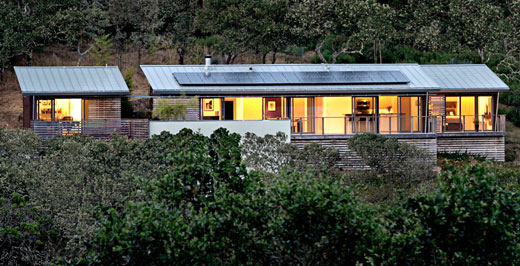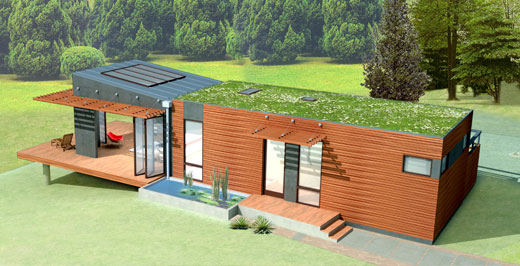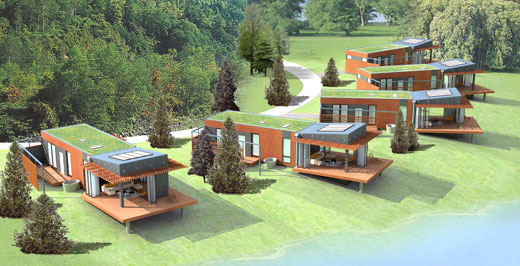Well-behaved Homes
 [Image: The Glidehouse by Michelle Kaufmann].
[Image: The Glidehouse by Michelle Kaufmann].Architects Michael McDonough and Michelle Kaufmann are now on stage here at Dwell on Design.
Their topic is "Well-behaved Homes."
Michael, in full performance mode, explains that building houses using conductive materials (metal, for instance, which is also used to make pots and pans) instead of using insulating materials (he specifically refers to aerated autoclave concrete, used in the majority of European houses) is inherently problematic from the standpoint of energy efficiency and climate control.
He talks about the importance of mechanical engineers in coming to understand the movement of air through enclosed architectural structures.
McDonough's firm is now developing what he calls the eHouse, a kind of domestic research station in New York state through which they can test out the use of more energy-efficient – and climate-appropriate – building materials.

 [Images: Michelle Kaufmann's mkLotus house].
[Images: Michelle Kaufmann's mkLotus house].Michelle Kaufmann, meanwhile, still speaking as I type this, is introducing everyone to green roofs, rainwater catchment, passive/active solar energy systems, and the relatively streamlined construction process involved in assembling one of her projects. She even, briefly, touched on issues of affordability (or the lack thereof).
She just finished up, in fact.
Anyway, I can't help but wonder, referring to the title of this panel, what a non-well-behaved home might be.
In fact, one of the respondents literally just mentioned this, in a passing reference to the possibility of "outlaw homes," which she describes as homes whose owners tear up the front yard to plant vegetable gardens.
But is that not just another way of being well-behaved? Eating right, being a good neighbor?
What if you installed a shake table in your front yard?
Is there a modernism for bad neighbors?
(Note: I'll be live-blogging the Dwell on Design conference this weekend; expect more posts soon – and bad editing or typos might have to stay up for now. Please excuse any such editorial lapses...)





Comments are moderated.
If it's not spam, it will appear here shortly!
the question of social and labor effects of 'green' construction is quickly becoming one of my hobby horses. i've gotten to saying that you can't be green without blue. how are these new structures built? who builds 'em? what are they paid? what's the transportation impact? were any of these questions asked?
No, those questions weren't asked - but you can see my own thoughts on architectural sustainability here.
don't you think it is interesting that Kauffman plants her "green" homes on not so green turf grass (referencing the rendering). Does she do this for purposes of marketing accessiblity or as a way of demonstrating a common lack of consideration for practices of runoff control, infiltration, diversity and context, or is it architectual tunnel vision with the "good for earth" guise "green"
the new view of a future habitats has got zbigniew oksiuta /architect from poland/. "The future habitat will be a biological space that does not mechanically copy biological processes or nature itself.", "The „Spatium Gelatum” (frozen space) project is a scientific work combining art and architecture.
The project aims at creating a future habitat and a biological space."
http://www.oksiuta.de/
Oh, Mr. McDonaugh--
I wasn't there, but did he really simplify sustainability down to "insulation is good?" The man who claims to have invented "lifcycle cost?" What about labor, embedded energy, and the existence of more than one climate zone in the US, not to mention the world? I don't think using AAC is going to fix all of our problems. This seems to me to be the start of a great internal Sustainability War in which the practitioners with the most clout battle it out to promote their own proprietary solutions to global warming.
Post a Comment